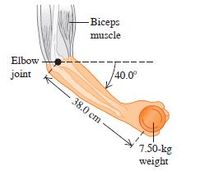A 72.0 kg weightlifter doing arm
raises holds a 7.50 kg weight.
Her arm pivots around the
elbow joint, starting 40.0° below
the horizontal (Fig.).
Biometric measurements have
shown that, together, the forearms
and the hands account for 6.00%
of a person’s weight. Since the
upper arm is held vertically, the
biceps muscle always acts vertically
and is attached to the bones
of the forearm 5.50 cm from the
elbow joint. The center of mass of this person’s forearm–
hand combination
is 16.0 cm from the elbow joint, along the bones of the forearm,
and she holds the weight 38.0 cm from her elbow joint. (a) Draw a freebody
diagram of the forearm. (b) What force does the biceps muscle
exert on the forearm? (c) Find the magnitude and direction of the force
that the elbow joint exerts on the forearm. (d) As the weightlifter raises
her arm toward a horizontal position, will the force in the biceps muscle
increase, decrease, or stay the same? Why?

Trending nowThis is a popular solution!
Step by stepSolved in 4 steps with 1 images

- A UNIFORM ROD OF LENGTH 3M AND WEIGHT 100N, WITH ENDS A ANDB RESTING ON TWO BRACKETS, BEARS 5ØN WEIGHT 0.5M FROM END A AND 150N WEIGHT 2M FROM FIRST WEIGHT. FIND THE REACTION FORCES AT B AND A. FB FA Aarrow_forwardIn the figure below, the cg of the pole held by the pole vaulter is 2.54 m from the left hand, and the hands are 0.733 m apart. Assume the vaulting pole has a mass of 3.32 kg.) (a) calculate the force (in N) exerted by his right hand ( enter the magnitude.) (b) calculate the force (in N) exerted by his left hand. ( enter the magnitude) (c) If each hand supports half the weight of the pole in the figure below , show that the second condition for equilibrium (net τ = 0) is satisfied for a pivot other than the one located at the center of gravity of the pole. Explicitly show how you follow the steps in the Problem-Solving Strategy for static equilibrium described above. Figure C is the last diagramarrow_forwardA uniform drawbridge must be held at a 37° angle abovethe horizontal to allow ships to pass underneath. The drawbridge weighs45,000 N and is 14.0 m long. A cable is connected 3.5 m from thehinge where the bridge pivots (measured along the bridge) and pullshorizontally on the bridge to hold it in place. What is the tension in the cable?arrow_forward
- metre'rule and an arrow to represent the force F provided by the student's hand. What is the relationship between magni- tudes of Fand W? in Fig. 2, the rule is held horizontally between the thumb and first finger. On a copy of Fig. 2, draw and label all the forces acting on the metre rule. List these forces in order of increasing magnitude. [C, '91}arrow_forwardA 500.-N uniform rectangular sign 4.00 mwide and 3.00 m high is suspended from ahorizontal, 6.00-m-long, uniform, 100.-N rodas indicated in Figure P8.25. The left end ofthe rod is supported by a hinge, and the rightend is supported by a thin cable making a30.0° angle with the vertical. (a) Find the tensionT in the cable. (b) Find the horizontaland vertical components of force exerted onthe left end of the rod by the hinge.arrow_forwardA uniform beam has a length of 17.7 m and a mass of 39.6 kg. The beam is horizontal and resting (in equilibrium) on two supports. One of the supports is located 3.32 m to the right of the beam's center of mass. This support applies an upward force of 245 N to the beam. Ehat distance separates the two supports?arrow_forward
- y T F х F, An object is subjected to three forces as shown in the figure. Assume F1 = 80.0 N and F2 = 95.0 N, what is T if the object is in static equilibrium? Enter a number with three significant digits.arrow_forwardThe forearm of length Larm = 35.2 cm shown in the figure is positioned at an angle with respect to the upper arm, and a 5.05-kg ball is held in the hand. The total mass motal of the forearm and hand is 2.75 kg, and their center of mass is located at Le 15.0 cm from the elbow. The biceps muscle attaches to the forearm at a distance Lbiceps = 4.5 cm from the elbow. What is the magnitude of the force Fbiceps that the biceps muscle exerts on the forearm for 0 = 27"? Foiceps 451.9 Fjoint Incorrect What is the magnitude of the force Fjoint that the forearm exerts on the elbow joint for 0= 27"? 375.4 N N AIarrow_forwardTo pull with a force F=160 N on the scale as shown, what should the tension in your biceps muscle be? The distance h = 0.28 m.arrow_forward